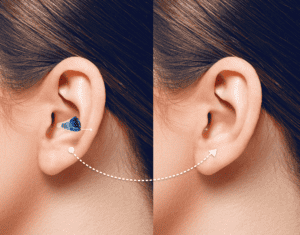
In-the-ear (ITE) hearing aids
Virtually invisible helpers
In-the-ear (ITE) hearing aids are typically custom-fitted to your ear canal and available in various colours to make it almost impossible to detect. Made from a mould of your ear, they’re manufactured individually for each customer, with the exception of a few models that are ready-to-wear. Costs vary, and it’s important to know that larger hearing aids offer more amplification (this applies to both ITE and BTE devices). ITE hearing aids are suitable for users with mild to moderate hearing loss.
Concha
The largest ITE model goes into the visible part of the ear canal, the concha (which means “shell”). It comes with directional microphones, volume control, push-buttons for specific ambient programmes, and longer battery life. Because of their size, they are typically more comfortable to use and maintain than other ITE hearing aids.
In-the-canal
The second biggest ITE model is barely detectable. Similar to devices that sit in the visible ‘bowl’ of the ear, in-the-canal (ITC) hearing aids have extended battery life, directional microphones, volume control and various ambient programmes. ITC devices are suitable for users with mild to moderate hearing loss.
Completely-in-the-canal
The smallest among the ITE models, completely-in-the-canal (CIC) hearing aids are placed deep in the ear canal and are virtually invisible. Its size necessitates the use of small batteries, which you need to replace more frequently. CIC devices are suitable for users with mild hearing loss.
Which device is right for you?
In-the-ear hearing aids tend to be smaller than behind-the-ear types. CIC devices, in particular, are nearly invisible. We look at three things when determining whether ITE hearing aids are a good fit:
- Sufficient space in the ear canal for the hearing aid.
- Mild to moderate hearing loss, to manage with the available level of amplification offered by tiny devices.
- The user’s experience of the occlusion effect (the dull sound of your own voice, which is often unavoidable due to the hearing aid “blocking” the ear canal).


